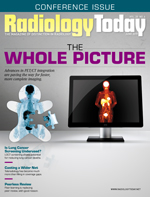 Editor’s Note: Network Connectivity
Editor’s Note: Network Connectivity
By Dave Yeager
Radiology Today
Vol. 20 No. 6 P. 4
We live in an increasingly connected world. As mobile devices of all shapes, sizes, and processing speeds buzz around cyberspace, linking and chatting with one another, people all over the globe are devising ways to allow more devices to link and chat faster than ever before. And those virtual connections are growing in importance, despite much being made of the seemingly corresponding loss of personal connections. Where personal connections are impractical or impossible, virtual connections can bridge the gap. Even at a local level, connectivity can be of paramount importance. This is especially true in health care.
I can think of few examples where connectivity is more important than it is in teleradiology. Beth W. Orenstein sheds some light on that topic in this issue by noting the trends that are shaping teleradiology and where it may be headed. Along the way, she highlights some instances where teleradiology has made a dramatic difference in the quality of care for the people who have benefited from it. The ability to receive subspecialty reads in even remote locales brings much-needed expertise to places where it’s in short supply, but larger organizations may benefit as well from the streamlining that teleradiology offers.
Connections among peers also figure prominently in another feature by Orenstein, this one dealing with peer review or, more specifically, peer learning. Traditional peer review has been a sore spot among radiologists because no one wants to embarrass their colleagues or be embarrassed by them. This is one reason that the practice has, on the whole, yielded little quality improvement. A new paradigm, however, is taking shape. The peer learning model removes the social disfavor component and presents anonymized cases in a collaborative learning environment. The early returns are positive.
Sometimes, an effective connection is simply a matter of finding the proper fit, as is the case with lung cancer screening. Keith Loria reports on the disconnect between the benefits of low-dose CT for lung cancer screening and those who could benefit the most. Loria details many of the reasons for this particular lack of connectivity, but he also provides insight from those in the field about how to help more people get screened so they can find cancers earlier, when they’re easier to treat.
Finally, this month’s cover feature by Dan Harvey profiles a different sort of connectivity. Researchers at the University of California, Davis, have developed a whole-body PET/CT scanner that can image an entire body without stitching images of multiple body areas together. Whether the method ultimately gains wide use depends on several factors, but it’s clearly an advance in the way that PET/CT—itself two connected modalities—is performed.
Enjoy the issue.

